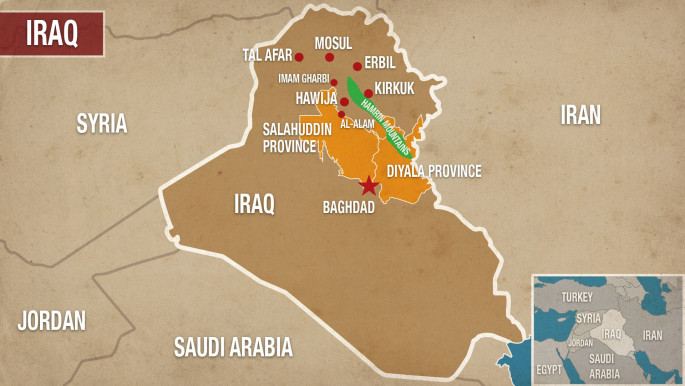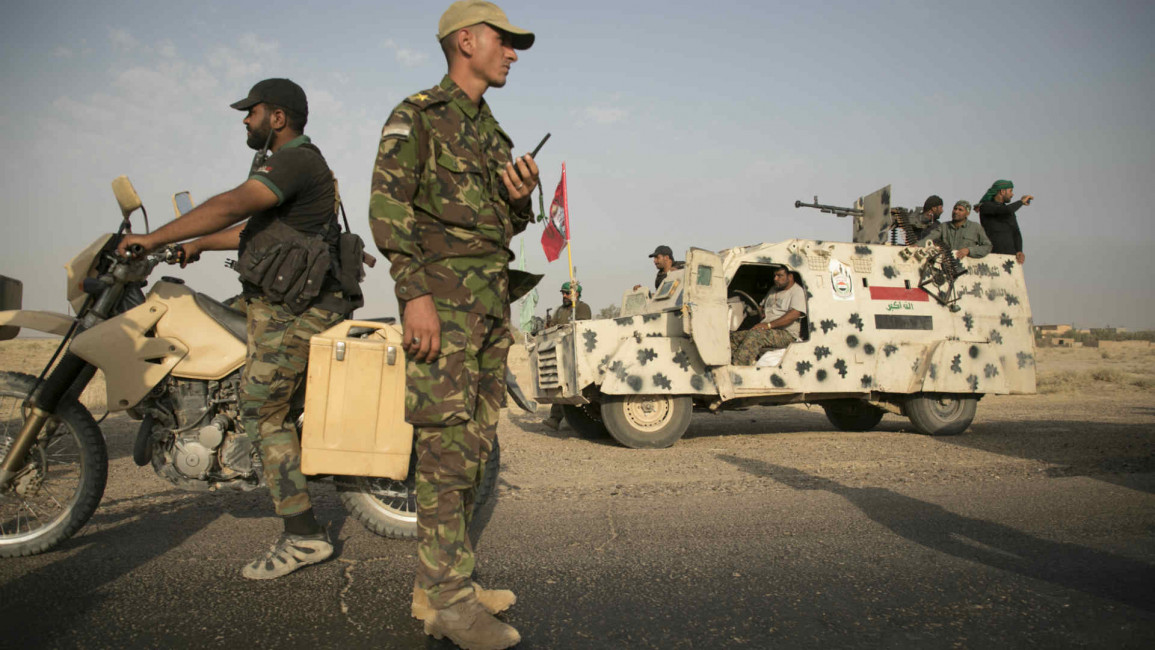
Two dudes embed in Hawija
As soon as we crossed the border from Iraq's Kurdistan, through Mosul and into Kirkuk province, the scene changed. The buildings were shot up, the windows broken and the villages we drove through showed all the usual scars of war. The closer we got to the frontline of the Hawija offensive, the more vans and cars we saw packed full of families with their lives strapped to the roofs to escape the battle.
We left Erbil early on Saturday, about 5am to avoid the lines at checkpoints, hoping the morning in the soldiers’ eyes would make it less likely for them to put much effort into checking the travel permissions we didn’t have. The checkpoints were eerily empty and the few soldiers just waking up waved us by without a second thought. While we drove, our interpreter made phone calls to her connection in the Iraqi army for our embed.
We arrived at Camp Speicher, a command base in Tikrit, as the sun was beginning to heat the day. A group of officers stood waiting outside by a wall, painted with a mural of an Iraqi soldier beating an Islamic State group militant with a bat. The entourage brought us into their command room and began briefing us on the situation, as it existed that day.
Before the offensive began, helicopters flew over villages, dropping thousands of leaflets informing residents and potential militants of the military’ imminent plan to liberate Hawija and the surrounding region. Brigadier General Waleed Khalifa expected anywhere between 500 and 1,000 IS militants, but also told us he believed many had escaped in the days leading up to the offensive.
“This is what happened in Tel Afar,” Lieutenant Colonel Jaafer explained. “ISIS is on the run.”
Operations began with Iraqi soldiers blockading the roads in and out of the village. Once the perimeter was secure, the general told us Iraqi forces called in 12 US-backed airstrikes in order to eliminate larger weapons caches before the ground assault.
 |
| A lone PMF fighter walks through the smoke of burning oil wells on the outskirts of Hawija [Adam McCaw/AMYKMedia] |
The three of us, Z, our fixer, and the pair of us journalists – Adam, a former US Special Forces soldier, and me, a former paramedic - piled into a cramped Humvee and left the Forward Operating Base to head to the frontlines.
“How many vehicles are in this convey?” Adam shouted over the roar of the engine to our driver.
“It’s just us!” he replied with a smile.
Adam looked over at me as we swiftly buckled our helmets, and started to laugh.
Driving down the desert roads approaching the front, we noticed thick black smoke fogging the horizon. A thin and weathered young soldier told us militants had set light to the oil fields the night before, in hopes of masking IS targets from coalition airstrikes.
As the Humvee sped down the IED-cratered pavement, we began to see packs of home–made tanks, clad in welded sheet metal, collect ahead. Eventually, we met the mob. The traffic jam was a mass of Popular Mobilization Forces (PMF) who were all jockeying for the lead position in the move into the first village.
It was like stepping into a time that wasn’t quite the past, but was certainly not of the modern era of warfare.
Men walked along the side of the road with cigarettes hanging from their lips and M-16s slung over their shoulders. A pick-up truck sagged with the weight of a .51 caliber DShK, a Soviet heavy machine gun, sitting in its bed. Men sang anthems and war cries echoed through the valley.
 |
|
| [Click to enlarge] |
The Iraqi army attempted to make an organized unified front moving into the first structures on the outskirts of a village. The swarm of PMF vehicles almost immediately foiled the army’s planned structure, breaking their lines in a rush to engage the enemy. Dusty tanks barraged the buildings, and groups of men in mismatched camouflage streamed into the smoldering structures to clear them. Muffled gun shots could be heard from the road.
Stepping out of the truck and climbing onto the roof of the Humvee to get a better look, we saw a mass of hundreds of PMF fighters and vehicles that dwarfed the gathered national army. It was a horde of biblical proportions. One thing was clear; this was the militia’s fight.
Adam and I began walking on foot, pushing forward to the frontlines. It was interesting how even though bullets were zipping by, many of the men stopped, threw up a peace sign and motioned for us to take their photo.
As the fighting began to die down, members within the Asa’ib Ahl al-Haq (an Iranian funded militia operating under the umbrella of the PMF) began to take note of our presence. A small scuffle broke out with shouts and fingers pointed in our direction. Our interpreter made it clear, we being Americans weren’t safe. Between 2005 and 2008 Asa’ib directly fought British and American forces, attacking military bases, taking several US soldiers hostage and downing British helicopters. Heading back to our Humvee, Z tells us that the group was committed to the grudge and we should return to the Iraqi base for the night.
Sunday’s operations in Hawija were similar. The effort to liberate the region was met with underwhelming resistance. Late on Wednesday, joint Iraqi forces declared Hawija, the last IS stronghold in northern Iraq, liberated.
 |
| Yomi Kleinmann (L) interviews Iraqi Army Brigadier-General Waleed Khalifa. 'I want the world to know there is no place in Iraq for IS and terrorism,' he says [Adam McCaw/AMYKMedia] |
The next push to remove the Islamic State group from Iraq’s borders lies in the tribal lands of Anbar. The expansive territory of western Iraq has historically been difficult to manage. Coalition forces declared Anbar unwinnable in 2006. More recently, the Syrian government made a deal with IS to shuttle its fighters from its northern border into the region. Many of these militants have been suspected of moving into the Iraqi city of Al-Qa’im.
Back at the FOB, General Waleed tells us his soldiers “are excited for total victory”. Spirits “are high after Mosul and Tel Afar”.
I asked what would happen to Kirkuk, an oil-rich city that is at the centre of a territorial dispute between Erbil and Baghdad. After a moment to choose his words, the general looked at me, understanding the intent of my question, and simply said, “Kirkuk is an Iraqi city, it will stay that way.”
The muscle that the Iraqi army has in utilizing these wild, yet undeniably effective PMFs leads me to believe he is right.
Adam McCaw and Joachim "Yomi" Kleinmann are a photography and print journalism team covering areas of conflict.
Adam spent several years in the US Army Special Forces and has a working knowledge of deep infrastructure in the Middle East. Yomi has a background as an EMT, giving the team unparalleled experience in hostile environments.




